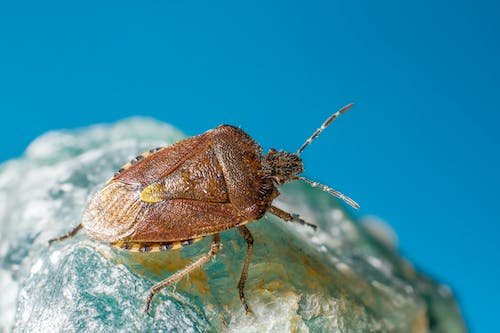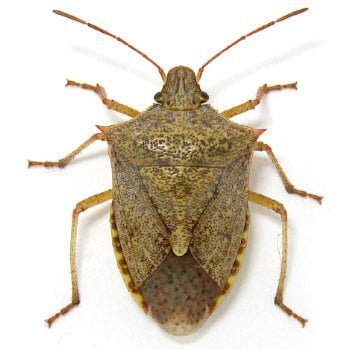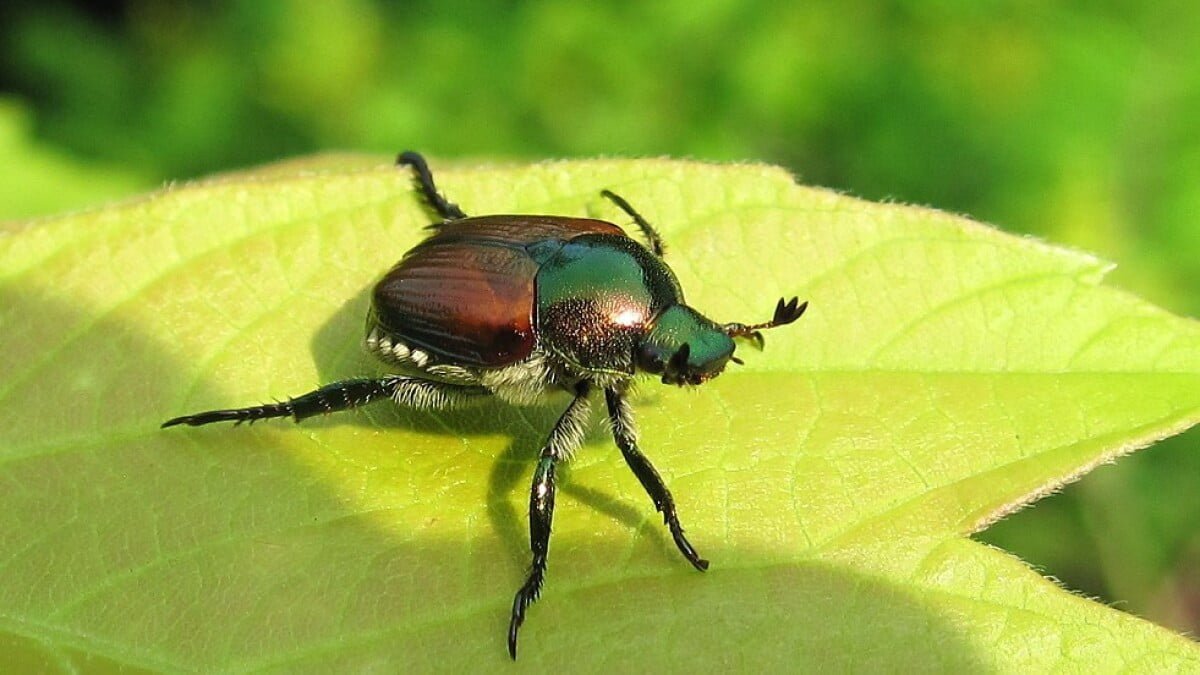Stink Bug insect Facts, FAQs, Behaviour, Habitat, Conservation and more

Stink Bug insect Facts | Description | Distribution and Habitat | Conservation | Behaviour and Ecology | Interaction with Human | Cultural | Interesting facts | frequently asked questions about Stink Bug
The Stink Bug, also known as shield bug or stink beetle, is a notorious insect that has garnered quite a reputation for its pungent odor and destructive feeding habits. These bugs belong to the family Pentatomidae, and are easily recognizable by their distinctive shield-shaped body and piercing-sucking mouthparts. While they are not harmful to humans, their presence can cause significant damage to crops and ornamental plants, making them a major pest for farmers and gardeners alike. In this article, we will explore the fascinating world of stink bugs, their behavior, habitat, and ways to control their populations. Join us as we uncover the secrets of this infamous insect and learn how to protect your plants from their destructive ways.
Taxonomy of Stink Bug
| Domain | Kingdom | Phylum | Class | Order | Family | Genus | Species |
|---|---|---|---|---|---|---|---|
| Eukarya | Animalia | Arthropoda | Insecta | Hemiptera | Pentatomidae | Various | Various (by species) |
Please note that the family Pentatomidae includes numerous genera and species of stink bugs, and the taxonomy at the genus and species levels may vary depending on the specific type of stink bug being referred to.
Morphology of Stink Bug
| Body Part | Description |
|---|---|
| Head | Triangular in shape with two antennae, compound eyes, and a mouthpart that pierces and sucks liquids |
| Thorax | Composed of three segments and bears six legs |
| Abdomen | Composed of 11 segments and contains the reproductive and digestive organs |
| Wings | Two pairs of wings, the first pair being thickened and hardened, forming a protective shield |
| Color | Varied, ranging from brown, green, to black and often marked with distinct patterns or stripes |
| Size | Varies depending on the species, typically ranging from 1 to 2 cm in length |
| Special Structures | Stink glands located on the underside of the thorax that emit a foul-smelling liquid for defense |
Please note that the morphology of stink bugs may vary depending on the species, and this table provides a general overview of their physical characteristics.

Description of Stink Bug
The Stink Bug is an insect that belongs to the family Pentatomidae, characterized by a shield-shaped body and piercing-sucking mouthparts. They are commonly called shield bugs or stink bugs due to their defensive mechanism of emitting a pungent odor from glands located on the underside of their thorax when threatened or disturbed.
Stink bugs vary in size and coloration, depending on the species, and can range from 1 to 2 cm in length. Their colors can be green, brown, or black, and they may be marked with distinct patterns or stripes. They have two pairs of wings, with the first pair being thickened and hardened, forming a protective shield over the body.
Stink bugs are found in various habitats, including agricultural fields, gardens, and forests, and are known to be destructive pests to crops and ornamental plants. They feed on plant sap using their piercing-sucking mouthparts, causing damage to the plant tissue and reducing crop yields.
While stink bugs are not harmful to humans, their foul odor can be a nuisance when present in large numbers. Additionally, their presence in homes or buildings during the fall and winter months is common, as they seek shelter from the cold weather. Control methods for stink bugs include physical removal, habitat modification, and insecticides.
Distribution and habitat of Stink Bug
Stink Bugs are found in almost every continent, except for Antarctica. They are most commonly found in temperate and tropical regions of the world, including North and South America, Europe, Asia, and Africa. The specific distribution of stink bugs may vary depending on the species and their preferred habitat.
Stink bugs are known to inhabit a variety of habitats, including agricultural fields, gardens, forests, and urban areas. They are often associated with plants and are known to be destructive pests to crops and ornamental plants. Some species of stink bugs are specific to certain host plants, while others have a broader range of plants they feed on.
Stink bugs are also known to seek shelter in homes and buildings during the fall and winter months, as they are attracted to warm and dry environments. They may enter buildings through cracks and gaps in windows and doors, and their presence can be a nuisance due to their foul odor.
Overall, the distribution and habitat of stink bugs are dependent on the species, but they are generally found in areas with ample plant life and warm, dry environments.
Behaviour and Ecology of Stink Bug
Stink bugs are known for their unique defensive mechanism of emitting a foul-smelling odor when threatened or disturbed, which acts as a deterrent against predators. This odor is produced by specialized glands located on the underside of the thorax and can linger for a long time, making the stink bug less appealing to potential predators.
Stink bugs feed on the sap of plants using their piercing-sucking mouthparts. They can cause significant damage to crops and ornamental plants by feeding on the plant tissue, leading to reduced yields and plant growth. Some species of stink bugs are specific to certain host plants, while others have a broader range of plants they feed on.
Stink bugs have a complex mating behavior, with males emitting pheromones to attract females. After mating, the female will lay clusters of eggs on the underside of leaves, which will hatch into nymphs that resemble smaller versions of the adult stink bug. The nymphs will go through several molts before reaching adulthood.
Stink bugs are most active during the day and are known to seek shelter during the night. They are also attracted to light and may congregate around streetlights or porch lights at night. Stink bugs are generally not harmful to humans, but their presence in large numbers can be a nuisance due to their foul odor.
In terms of ecology, stink bugs play a role in their ecosystem as both predators and prey. Some species of stink bugs are known to feed on other insects, while others are preyed upon by birds, spiders, and other predators. Overall, stink bugs are an important part of their ecosystem and can have both positive and negative impacts on the environment.
Conservation of Stink Bug
Stink bugs can have significant economic impacts on crops and ornamental plants, making their conservation and management an important consideration for farmers and gardeners. While some species of stink bugs are considered beneficial due to their role as predators of other insects, many species are destructive pests and can cause significant damage to crops and plants.
One approach to managing stink bugs is through the use of integrated pest management (IPM) strategies. This approach involves the use of a combination of techniques, such as crop rotation, cultural practices, biological control, and the use of insecticides, to minimize the damage caused by stink bugs while minimizing the impact on non-target organisms and the environment.
Biological control involves the use of natural enemies, such as parasitoids and predators, to control stink bug populations. This approach can be effective in reducing stink bug populations without the use of chemical pesticides. For example, some species of wasps are known to parasitize stink bug eggs, helping to reduce the number of stink bugs that reach adulthood.
Cultural practices, such as planting trap crops or removing crop residue, can also help to manage stink bug populations. Trap crops are plants that are attractive to stink bugs and can be planted as a decoy crop to lure stink bugs away from the main crop. Removing crop residue can also help to reduce the number of overwintering stink bugs, as they often seek shelter in plant debris.
Conservation efforts for stink bugs are less common, as many species are not considered endangered or threatened. However, preserving natural habitats and promoting biodiversity can help to support populations of beneficial stink bug species and other beneficial insects.
In summary, managing stink bugs requires a combination of approaches that minimize the use of chemical pesticides while effectively controlling stink bug populations. Conserving natural habitats and promoting biodiversity can also help to support populations of beneficial stink bug species and other beneficial insects.
Interaction with Human of Stink Bug
Stink bugs are generally considered a nuisance to humans due to their foul odor and tendency to seek shelter in homes and buildings during the fall and winter months. When disturbed or crushed, stink bugs release a pungent, unpleasant odor that can linger for a long time.
Stink bugs are also known to be destructive pests to crops and ornamental plants, causing significant economic damage to farmers and gardeners. In large numbers, they can cause reduced yields, stunted growth, and other problems for a variety of crops, including fruits, vegetables, and ornamental plants.
While stink bugs are generally not harmful to humans, they can cause allergic reactions in some people, particularly if they come into contact with the stink bug’s defensive chemicals. In rare cases, stink bugs have been known to bite humans, but their bites are not considered dangerous or venomous.
In recent years, stink bugs have become a growing problem in many parts of the world, and efforts are underway to manage their populations and minimize their impact on crops and plants. Integrated pest management strategies, including the use of biological control and cultural practices, are being employed to help manage stink bug populations and reduce their economic impact on farmers and gardeners.
Overall, while stink bugs can be a nuisance and cause economic damage, they are generally not harmful to humans and play an important role in their ecosystem as both predators and prey.
Cultural and Historical Significance of Stink Bug
Stink bugs do not have a significant cultural or historical significance in most societies. However, in some cultures, stink bugs may be seen as a symbol of good luck or fortune.
In some Asian cultures, for example, stink bugs are believed to bring good luck and prosperity to households. They are often depicted in art and literature as a positive symbol of good fortune and abundance.
In some Native American cultures, stink bugs were used in traditional medicine to treat a variety of ailments, including colds and respiratory infections. The plant that stink bugs were found on was also used in traditional medicine, suggesting that stink bugs may have played a role in traditional healing practices.
Despite their limited cultural and historical significance, stink bugs remain an important species in their ecosystem and are an important part of the food chain for a variety of predators. While they can be a nuisance and cause economic damage, efforts are underway to manage their populations and minimize their impact on crops and plants.
Explanatory Notes for Stink Bug
Stink bugs are a type of insect that belongs to the family Pentatomidae. They are known for their characteristic foul odor, which they release as a defense mechanism when threatened or disturbed.
Stink bugs are found in many parts of the world, with over 6,000 species known to exist. They are typically brown or green in color and have a shield-shaped body. They have a long, triangular-shaped head and a pair of antennae that are longer than their bodies.
Stink bugs are herbivorous and feed on a variety of plants, including crops and ornamental plants. They use their piercing-sucking mouthparts to feed on plant sap and can cause significant damage to crops and plants if present in large numbers.
Stink bugs are most commonly found in agricultural areas, but they can also be found in urban and suburban environments. They are known to seek shelter in homes and buildings during the fall and winter months, which can make them a nuisance to homeowners.
Stink bugs play an important role in their ecosystem as both predators and prey. They are preyed upon by a variety of predators, including birds, mammals, and other insects. They are also known to be predators themselves, feeding on other insects and invertebrates.
Efforts are underway to manage stink bug populations and minimize their impact on crops and plants. Integrated pest management strategies, such as biological control and cultural practices, are being employed to help manage stink bug populations and reduce their economic impact on farmers and gardeners.
Interesting facts about Stink Bug
- Stink bugs get their name from the foul odor they release as a defense mechanism when threatened or disturbed.
- There are over 6,000 species of stink bugs found throughout the world.
- Stink bugs belong to the family Pentatomidae, which includes both herbivorous and predatory species.
- Stink bugs can cause significant damage to crops and plants, including fruits, vegetables, and ornamental plants.
- Stink bugs have a shield-shaped body and can range in color from brown to green.
- Some species of stink bugs are known to be social and communicate with each other using vibrations and chemical signals.
- Stink bugs have a piercing-sucking mouthpart that they use to feed on plant sap and other insects.
- Stink bugs are preyed upon by a variety of predators, including birds, mammals, and other insects.
- When stink bugs overwinter in homes and buildings, they can be a nuisance to homeowners due to their foul odor and large numbers.
- While stink bugs can be a pest to farmers and gardeners, they also play an important role in their ecosystem as both predators and prey.
General queries or frequently asked questions about Stink Bug
What are stink bugs?
Stink bugs are a type of insect that belongs to the family Pentatomidae. They are known for their characteristic foul odor, which they release as a defense mechanism when threatened or disturbed.
Are stink bugs harmful to humans?
Stink bugs are not harmful to humans and do not bite or sting. However, they can be a nuisance in homes and buildings, especially during the fall and winter months when they seek shelter indoors.
Can stink bugs damage plants and crops?
Yes, stink bugs can cause significant damage to plants and crops, including fruits, vegetables, and ornamental plants. They use their piercing-sucking mouthparts to feed on plant sap and can cause discoloration, distortion, and other forms of damage.
How can I prevent stink bugs from entering my home?
To prevent stink bugs from entering your home, seal any cracks or gaps around windows, doors, and other entry points. You can also use screens and weather stripping to prevent stink bugs from entering. If you find stink bugs inside your home, vacuum them up and dispose of them outside.
What should I do if I have a stink bug infestation in my garden or on my crops?
If you have a stink bug infestation in your garden or on your crops, you can use integrated pest management strategies to manage their populations. This may include using natural predators, such as birds and parasitic wasps, or using insecticides as a last resort. It is important to consult with a pest management professional to determine the best course of action for your specific situation.
Can stink bugs fly?
Yes, stink bugs have wings and are capable of flying. However, they typically only fly short distances and are more commonly seen walking or crawling on plants and surfaces.
Do stink bugs have any natural predators?
Yes, stink bugs have a variety of natural predators, including birds, mammals, and other insects. Parasitic wasps are also known to attack stink bug eggs, which can help to reduce their populations.
Where do stink bugs come from?
Stink bugs are found in many parts of the world, including North and South America, Europe, Asia, and Africa. Some species are native to certain regions, while others have been introduced to new areas through human activities such as trade and transportation.
How long do stink bugs live?
The lifespan of a stink bug can vary depending on the species and environmental conditions. In general, stink bugs can live for several months to a year.
What is the economic impact of stink bugs on agriculture?
Stink bugs can cause significant damage to crops and plants, resulting in economic losses for farmers and gardeners. In the United States, the brown marmorated stink bug has caused significant damage to fruit and vegetable crops, resulting in millions of dollars in losses each year.
Conclusion
In conclusion, stink bugs are a diverse and fascinating group of insects that play important roles in their ecosystems. While some species are valued as predators of other insects, others can be pests that cause significant damage to crops and plants. Stink bugs are known for their distinctive foul odor and are commonly encountered in homes and buildings, particularly during the fall and winter months. Integrated pest management strategies can be used to manage stink bug populations, and it is important to consult with a pest management professional to determine the best course of action for specific situations. Stink bugs have cultural and historical significance in some parts of the world, and their interactions with humans can be both beneficial and problematic. Overall, stink bugs are an important and fascinating group of insects that continue to capture the interest of scientists and the public alike.












